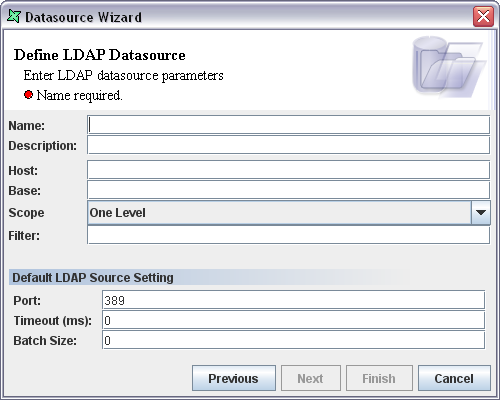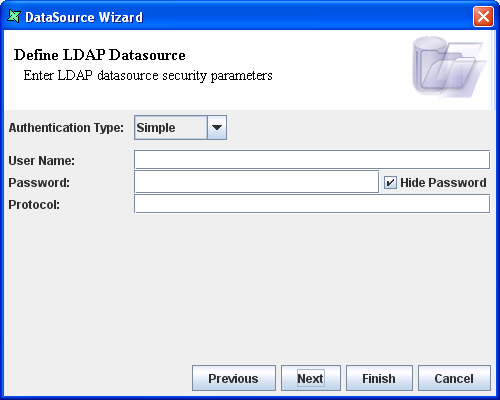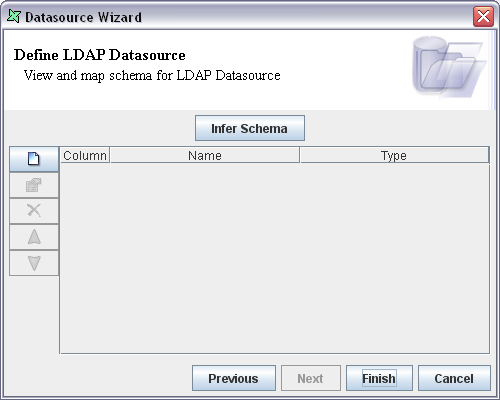The LDAP DataSource Wizard is shown in Figure 11.1, “LDAP DataSource Wizard”.
Name: Enter the DataSource name in the text box. This should be a unique name.
Description: Any extra description that is used to describe the data source can be entered in the Description text box.
Host: The host name or IP address of the server is specified here.
Base: The Base, sometimes called Distinguished Name (DN) is used to uniquely identify entries in LDAP. The base is always a fully qualified name that identifies entries starting from the root of the LDAP name space (as defined by the server).
The following string-type attributes represent the set of standardized attribute types for accessing an LDAP directory. The Base can be composed of attributes using the LDAP syntax. For example:
CN - CommonName
L - LocalityName
O - OrganizationName
OU - OrganizationalUnitName
C - CountryName
STREET - StreetAddress
If there are domain components com and
example, then the base for the com.example
domain is dc=com,dc=example. Similarly, if the organizational
unit comes under the domain com.example, then to access
people within the organization you would use
ou=people,dc=example,dc=com.
Scope: Scope defines the set of information used to search for data. You may choose one of three values: Object, One Level or Subtree. Choosing Object will only return data held by the object identified by the Base. Choosing One Level will return data held by children of the object identified by the Base (this is the default). Finally, Subtree will return data from all children in the subtree below the Base.
Filter: Search filters enable
you to define criteria for more efficient and effective searches.
LDAP filters are used to specify criteria for directory searches.
Filters are optional - if you leave it blank, a default filter
objectclass=* will be used.
In filter, the matchingAttrs argument is
converted into a string filter that is a conjunctive expression of
the attributes from matchingAttrs.
For example, when a matchingAttrs containing the attributes
sn:Geisel and mail: (no value given),
it is translated into the
string filter (&(sn=Geisel)(mail=*)).
The filter conventions are given in the ftp://ftp.isi.edu/in-notes/rfc2254.txt link.
Port: The default connection port is 389.
The LDAP port number of the machine on which the
Directory Services are running is specified in the text box.
Timeout: This is the time interval allowed for a certain operation to occur. The LDAP timeout is the time limit required to wait for the result. If 0 is specified, it means that the datasource will wait indefinitely.
Batch Size: The value of the batch size property specifies the batch size of the search results returned by the server. The batch size is specified in the Batch Size text box. A setting of 0 means that the provider should block until all the results have been received. If for instance the batch size is specified as 24 then the provider should block until 24 entries have been read from the server or until the enumeration terminates, whichever produces fewer number of results.
Click Next to display the LDAP Security page.
In Figure 11.2, “Security Parameters”, the default type none has been
changed to simple so that you can see the available options.
If your server does not require any authentication for read access,
you can leave the authentication type as none.
Authentication Type: The value of this property is a string that specifies the authentication mechanism(s) for the provider to use. The following values are defined for this property:
none: If this option is selected from the combo box, then no authentication is required. It is referred to as anonymous bind.
simple: If this option is selected, then a clear text password is used. This type of bind sends an unencrypted user name and password to the LDAP server for verification, and can be secured only by using a secure channel to transmit the password, e.g. SSL.
GSSAPI: GSSAPI stands for Generic Security Services Application Programming Interface. An application level interface (API) to system security services. It provides a generic interface to services which may be provided by a variety of different security mechanisms.
Digest-MD5: In Digest-MD5, the LDAP server sends data that includes various authentication options that it is willing to support, plus a special token to the LDAP client. The client responds by sending an encrypted response that indicates the authentication options that it has selected. The response is encrypted in such a way that proves that the client knows its password. The LDAP server then decrypts and verifies the client's response.
User Name: This property is used to specify the identity of the principal for authenticating the caller to the service.
Password: This property is used
to specify the credentials of the principal for authenticating the
caller to the service. By default, any text entered here is shown
as asterisks (*), unless you turn off the Hide Password option.
Protocol: The value of this property is a string that specifies the security protocol for the provider to use. The protocol is entered in the text box.
Click Next to display the screen as shown in Figure 11.3, “LDAP DataSource Schema”.
Click Infer Schema to query the LDAP server using the settings you have entered, and extract the schema attributes. The fields and the corresponding data types are displayed in the table. Click Finish to add the data source to the repository.


